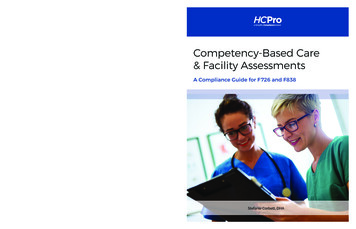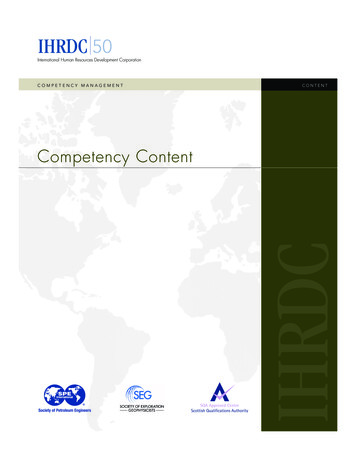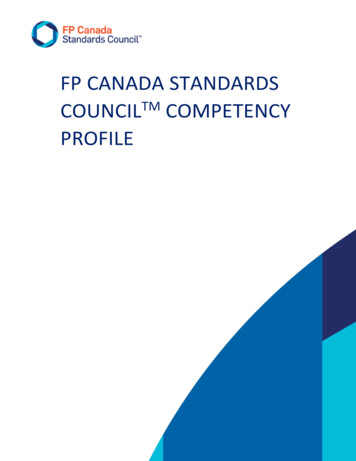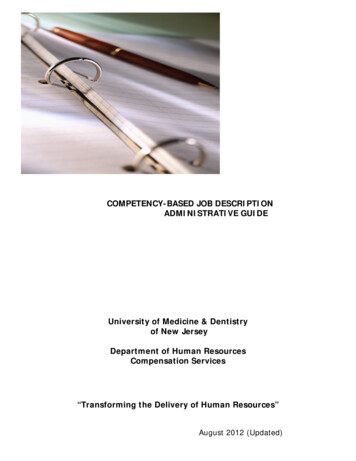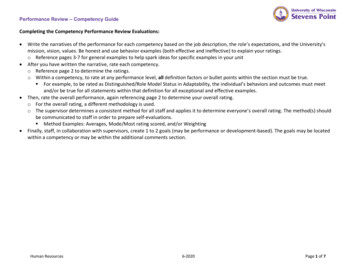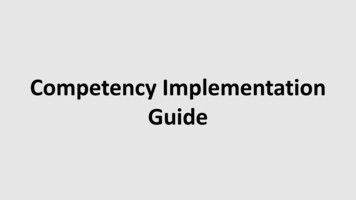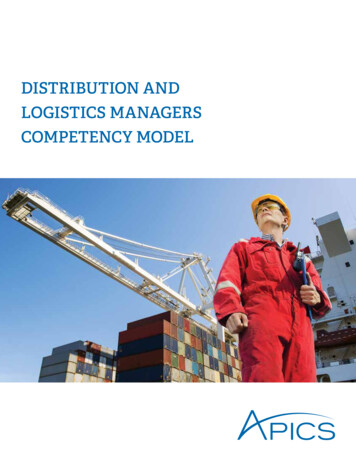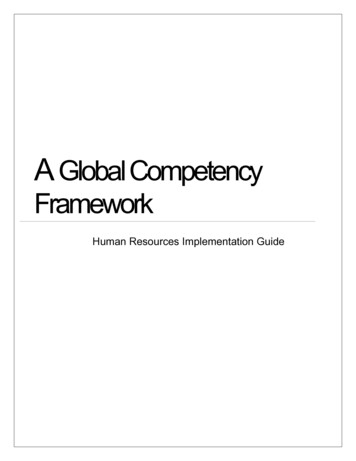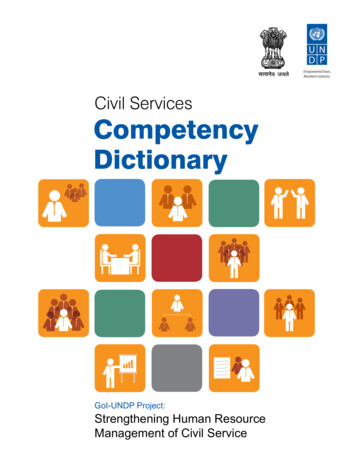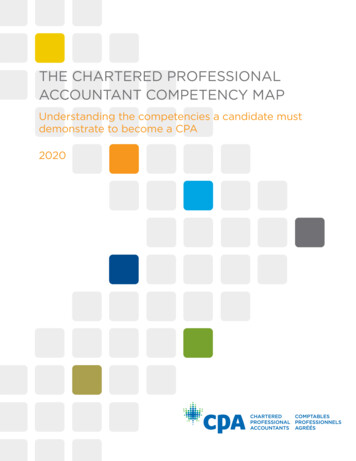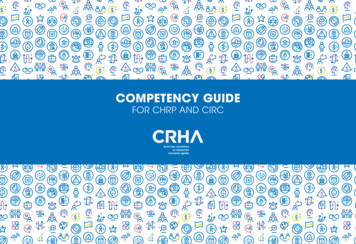
Transcription
COMPETENCY GUIDEFOR CHRP AND CIRC
THREE KEY COMPONENTS THAT WORK TOGETHER SYNERGISTICALLY :AL FIELDS OF COMNOPETIENESSFCYORPHEALTH ANDORGANIZATIONALRELATIONSHIPSANALYSISAND SYNTHESISTEAMWORKINTEGRATED TALENTMANAGEMENTONMPR AKO INCE GSSINN SPEEDOVATI L ST ION TYPERUCTUREROCTSE-2-GEGUATOTAL COMPENSATIONAND MOBILITYLANCOMPREHENSIVEVISIONMFO TEAZE RSI R/IHION TYPEBUSINESSACUMENORTERRITO GANIZATION’SRY OFACTIVITYBUTHE SINEOR SS UGANNIZ ITS INOATIRGONM ANAR IZKE ATT P IOHA N’SSEURGY IN YOTECHNOLO NAL ROLEPROFESSIOREGULATSTAFFINGIONMPETITLEVEL OF CORR/IS H ALLE A SSIONORFEPROCOMPETENCYDEVELOPMENT ANDSUCCESSION PLANNINGEENCRESNPNORGANIZATIONALDEVELOPMENTETIV SEC NTLL MECO REEAGOUNITECHNOLOIN ORGA GYNIZATIONINFLUENCEGUIDANCESUSDE TAINVELAOP BLEMENTAGOR E ONSMEDIAREEXPOSUSTRATEGICDEVELOPMENTOF ALHEALTH, SAFETYAND LEARNINGRELATIONALINTELLIGENCECISOHO VELYC LEPS SKRIDIGITALLITERACYOF PRACTNTEXTICECOSIO ZE ORG FANIZATIOAL COMPETENCNERIESEG
TABLE OF CONTENTSSTRATEGIC DEVELOPMENT OF ORGANIZATIONS — 2930 — ORGANIZATIONAL DEVELOPMENT31 — INNOVATION32 — TECHNOLOGYTHREE KEY COMPONENTS — 2PRESENTATION — 45 — DEFINITION OF “COMPETENCY”6 — MULTI-LEVEL STRUCTURECONTEXT OF PRACTICE — 3334 — SIZE OF ORGANIZATION34 — AGE OF ORGANIZATION35 — ORGANIZATION TYPE/LEGAL STRUCTURE35 — REGULATION TYPE36 — LANGUAGE36 — SECTOR37 — ORGANIZATION’S MARKET PHASE37 — NUMBER OF BUSINESS UNITS IN THE ORGANIZATION38 — ORGANIZATION’S TERRITORY OF ACTIVITY38 — LEVEL OF COMPETITION39 — UNION PRESENCE39 — COLLECTIVE AGREEMENTS40 — DECISION-MAKING PROCESS40 — SPEED OF INNOVATION41 — INFLUENCE OF EXTERNAL POLICY ON ORGANIZATION41 — MEDIA EXPOSURE42 — OHS RISK LEVEL42 — PSYCHOSOCIAL RISK LEVEL43 — DIVERSITY (ORIGIN, CULTURE, GENDER, AGE, DISABILITY)43 — CONCERN FOR SUSTAINABLE DEVELOPMENT44 — PRESENCE OF TECHNOLOGY IN ORGANIZATION44 — PRESENCE OF TECHNOLOGY IN YOUR PROFESSIONAL ROLE45 — YOUR ROLE ASHR/IR PROFESSIONAL45 — SIZE OF HR/IR TEAMGENERAL COMPETENCIES — 78 — ETHICS9 — AGILITY10 — GUIDANCE11 — BUSINESS ACUMEN12 — COMPREHENSIVE VISION13 — INFLUENCE14 — PROJECT MANAGEMENT15 — ANALYSIS AND SYNTHESIS16 — COMMUNICATION17 — RELATIONAL INTELLIGENCE18 — DIGITAL LITERACY19 — CONTINUOUS LEARNINGPROFESSIONAL FIELDS OF COMPETENCY — 20HEALTH AND ORGANIZATIONAL RELATIONSHIPS — 2122 — OCCUPATIONAL HEALTH, SAFETY AND WELLNESS23 — LABOUR RELATIONS24 — TEAMWORKINTEGRATED TALENT MANAGEMENT — 2526 — STAFFING27 — TOTAL COMPENSATION AND MOBILITY28 — COMPETENCY DEVELOPMENTAND SUCCESSION PLANNINGACKNOWLEDGEMENTS — 46-3-
COMPETENCY GUIDEFOR CHRP AND CIRCCo-created with current and potential users of the Guide, it provides a definitionof the HR/IR profession that is both grounded in reality and open to the future.The objective of the Guide is to redefine the HR/IR profession today and in thefuture through competencies, in the context of organizational transformation.The Guide is divided into three major sections, which work in synergy: General competencies Professional fields of competency (grouped in families) Context of practiceIn order to reflect ongoing professional development, a situation-specific scalewith five levels of proficiency has been prepared for each of the general competencies and each of the professional fields of competency.-4-
CONTEXTThe Competency Guide is based on a clear definition of theconcept of competency, drawn from Boudreault (2002), whodescribes it as “knowing how to act,” which is at the interfaceof knowledge, know-how, and soft skills, and is embodied in agiven context that may vary.LEDGEABLEDEFINITION OF“COMPETENCY”KNOWLEDGEKNOWSOFT SKILLSCOMPETENTEThere are also the assumptions that a competency must beobservable, is complex, and that individuals can develop itthroughout life, to the point of excelling in it. The illustration onthe following page presents the definition that has become thetheoretical framework on which the revised Guide is based.ETIVRAOPEFFECCONTEXTECONTEXTKNOW-HOW-5-TIV
MULTI-LEVEL STRUCTUREIn order to reflect ongoing professional development, a situation-specific scale with five levels of proficiency has been prepared for each ofthe general competencies and each of the professional fields of competency.It is essential to understand that professionals with a higher level for a competency are not necessarily more competent than other professionals at a lower level. Professionals are considered to be competent regardless of level (1 to 5).Professionals have the option to progress to a higher level if they are able to act independently in increasingly complex situations. The levelsare defined as follows :LEVEL 1 : Assess your environment in order to act independently in simple situations and identify a competent resource to act in complexsituations.LEVEL 2 : Act independently in simple situations and with assistance in more complex situations.LEVEL 3 : Act independently or in collaborative mode in complex situations.LEVEL 4 : Act as a resource and take part in the development of other professionals.LEVEL 5 : Improve the field.135FOR THE SAKE OF CLARITY AND TO AVOID REDUNDANCY, LEVELS 1, 3, AND 5 HAVE BEEN EXPLAINEDIN THE GUIDE IN THE SECTION THAT ADDRESSES “KNOWING HOW TO ACT.”-6-
GENERALCOMPETENCIESThere are 12 general competencies, which complement one another and areconsidered essential for adapting to a series of complex situations like thoseencountered in professional practice. These competencies help define what isexpected of a certified professional. When they are deployed in combinationwith any of the professional fields of competency, it is possible to assess thecompetence of a certified human resources professional or certified industrialrelations counsellor.-7-
ETHICSGeneral CompetenciesETHICSDisplay exemplary behaviour in accordance with laws, formal and informal standards, and social codes.Help to develop, support, and change behaviours, policies, and rules in line with work ethics.LEVEL 1 Comply with formal and informal laws andstandards as well as social codes that applyto the workplace. Distinguish between ethical and unethicalbehaviours. Identify situations that call for action. Comply with all ethical obligations, such asprofessional secrecy and the confidentialityand integrity of information. Have the courage to act and report anyidentified situations or behaviours deemedunethical. Take full responsibility for your decisions. Recognize when a situation requires thesupport of professionals with a higher levelof competency and seek their assistance.-8-LEVEL 3 Apply labour laws, collective agreements,case law, and corporate policy by identifyingsituations that may present an ethical issue. Identify risks of harm, including conflicts ofinterest, to the individuals involved. Establish and maintain the decision-makingframework, while safeguarding the relationship of trust with stakeholders at all times. Implement an approach or system to managesituations that may be ethically challenging. Exercise proper judgment during ethicallycomplex or ambiguous situations. Handle and ensure all personnel handlespersonal, professional, and corporate datain an appropriate and compliant manner.LEVEL 5 Develop new models or conceptualframeworks for work ethics. Design new professional ethics compliancetools. Demonstrate innovation in competencydevelopment and knowledge transfermethods. Take action to help the labour market andsociety as a whole progress in terms of ethics. Communicate developments in ethics(outside of the organization).
AGILITYGeneral CompetenciesAGILITYCapability to progress in an ambiguous, complex, and constantly changing environment.Foster adaptation and value creation through improvement loops by adjusting to context, people, and developments.LEVEL 1 Show open-mindedness with regard toproposed or implemented changes. Understand your environment as an evolvingsystem. Demonstrate flexibility when faced withuncertainty or ambiguity. Consider unexpected events and problemsas opportunities for value creation. Recognize changes in the environmentrequiring actions that exceed your capabilities and seek help. Complete your work even in ambiguoussituations.-9-LEVEL 3 Ask relevant and constructive questionsin order to better grasp the elements of acomplex situation. Collaborate with others with an eye onobjectives. Propose flexible and scalable solutionsconsidering stakeholders as well as thecurrent context and how it is likely to change. Implement concrete actions to handlecomplex situations and adjust based onresults. Guide peers through complex situations tohelp them to improve their own agility.LEVEL 5 Develop new models or conceptualframeworks related to agility in an organizational context. Design new tools to increase agility incomplex situations. Demonstrate innovation in competencydevelopment and knowledge transfermethods. Communicate developments in agility(outside of the organization).
GUIDANCEGeneral CompetenciesGUIDANCEHelp individuals, teams, or organizations find and implement concrete solutions that suit the context.Help solve problems or meet objectives.LEVEL 1 When a problem arises, analyze the needsand context of the individuals involved forbetter understanding. Establish relationships based on trust andcollaboration with internal and externalclients. Ask questions to help internal and externalclients come up with solutions on their own. Identify the best approach(es) to meet internal and external client needs. Propose ideas and examples based on yourlevel of expertise and knowledge. Recognize when a situation requires thesupport of professionals with a higher levelof competency and seek their assistance.- 10 -LEVEL 3 Obtain all the information needed forin-depth understanding of a situation beforeintervening. Help internal and external clients establishobjectives, identify and assess potential solutions, implement action plans, and evaluateresults in terms of objectives. Use your expertise to help internal andexternal clients by proposing solutions andformulating recommendations. Adopt an approach that favours the accountability and independence of internal andexternal clients.LEVEL 5 Develop new models or conceptualframeworks for advice and guidance in thework context. Design new tools to better guide individuals,teams, and organizations. Demonstrate innovation in competencydevelopment and knowledge transfermethods. Communicate developments in guidance(outside of the organization).
BUSINESS ACUMENGeneral Competencies- 11 -BUSINESS ACUMENAbility to identify opportunities and strategies that create value and to implement them in order to benefit the organization, workers, and society.LEVEL 1 Understand the economic, financial, marketing, human, and organizational challenges ofan action or a project. Master the general economic, financial,and marketing terms and concepts of anorganization. Detect value-generating business opportunities when they arise, to drive corporatesuccess. Communicate opportunities to the designated authorities within the organization. Maintain existing business relationships andpartnerships.
"COMPETENCY" The Competency Guide is based on a clear definition of the concept of competency, drawn from Boudreault (2002), who describes it as "knowing how to act," which is at the interface of knowledge, know-how, and soft skills, and is embodied in a given context that may vary. There are also the assumptions that a competency must be
